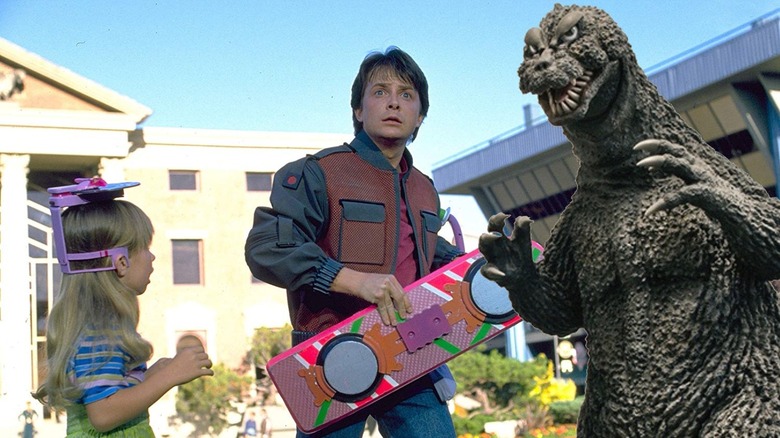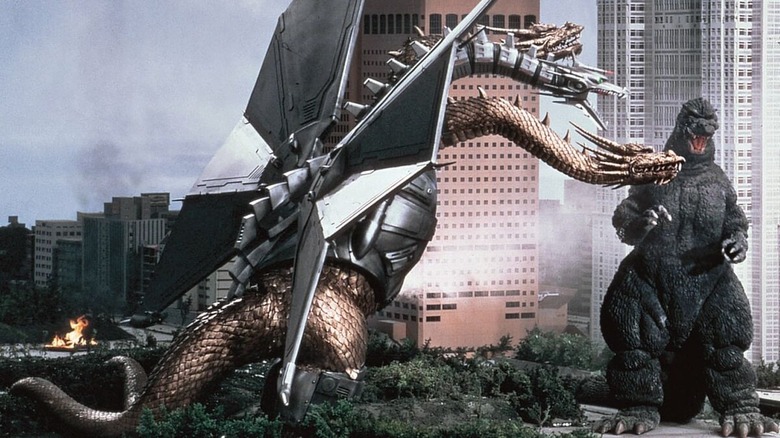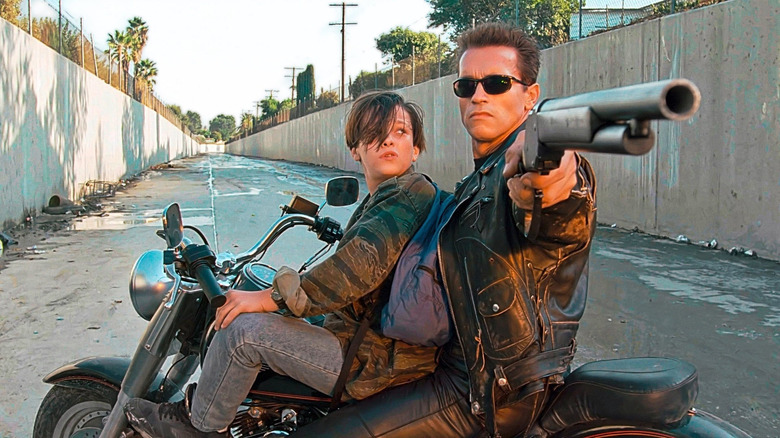How Back To The Future 2 Altered The Course Of The Godzilla Franchise
Robert Zemeckis' blockbuster "Back to the Future Part II" was released in November 1989, and it expanded on the lore from the first. In the 1984 original, Marty McFly (Michael J. Fox) went back in time to the 1950s when his parents were teenagers ... and not terribly interested in each other. To ensure he gets born, Marty has to arrange circumstances so that his mom and dad start dating. In "Part II," Marty is enlisted by Doc Brown (Christopher Lloyd) to travel to the far-flung future of 2015 to make sure that his kids stay out of legal trouble; this will be easy to do, as Marty's son (also Fox) happens to look just like him.
And, no, hoverboards aren't real. That was a rumor Zemeckis started himself.
The "Back to the Future" movies play fast and loose with causality but offer audiences a chance to feel like they're smart. In short, they're a hoot, providing raucous adventure and light comedy. It's no wonder the "Future" movies were as successful as they were. "Part II" was made for a budget of $40 million, but made over $332 million worldwide. Time travel, it seems, was hip in 1989.
Indeed, "Part II" was so successful, it directly influenced the Godzilla franchise. This was openly confessed by screenwriter Kazuki Omori, the director of 1989's "Godzilla vs. Biollante" and its amazing 1991 follow-up "Godzilla vs. King Ghidorah." In an interview from 2022, Omori admitted that "Biollante" was a strange animal — literally; Biollante is a mutated crocodile-like rose bush — and that the success of "Back to the Future Part II" got Godzilla creator Tomoyuki Tanaka thinking about a Godzilla story that would feature time travel.
What resulted is one of the best Godzilla films of the Heisei era.
Godzilla vs. King Ghodorah
The story for "Godzilla vs. King Ghidorah" is wild. Beings from the future arrive in Japan and explain that, in their time, the Earth has been completely devastated by Godzilla. They explain that Godzilla was born of a still-living tyrannosaurus-like dinosaur that was exposed to a nuclear blast back in the 1940s and that if they go back in time and kill that dinosaur, Godzilla will no longer exist. It turns out, however, that the time travelers — called Futurians — have a sinister secondary scheme; they will leave a trio of cute-looking fanged monsters called Dorats in the 1940s, knowing that exposing them to 1940s-era radiation will create King Ghidorah. Sure enough, back in the present, the Futurians have manifested King Ghidorah and intend to use him to take over the world. Luckily, in the 1940s, the Futurians only injured that tyrannosaurus, and the Japanese government mobilizes to find it, irradiate it, re-create Godzilla, and have a warrior to fight King Ghidorah.
Omori recalls a conversation he had with Tomoyuki Tanaka, who was baffled as to how an American time travel movie could be more successful than "Godzilla vs. Biollante." He said:
"At the same time as 'Godzilla vs. Biollante,' 'Back to the Future Part II' was playing in cinemas. When my producer Tanaka actually went to a movie theater, he noticed that this film was better attended. He asked: 'Why's that?' I told him: 'Yes, there are elements of time travel in it, which probably appeals to young people.'"
Not even Godzilla was immune from chasing trends. If time travel stories were de rigueur, then Godzilla was going to get tangled up in causality.
Time travel is so hip!
To Omori's recollection, Tanaka felt that time travel was too wild, even for a series that regularly featured space aliens and monster fights on distant planets. He said:
"Tanaka was originally not into time travel, it was too much for him. He said, 'If you allow time travel, anything is possible.' Until then, Tanaka didn't want to do anything with time travel. But when he saw how well 'Back to the Future Part II' was performing, he changed his mind. He said, 'Okay, let's try this thing with Godzilla and time travel.' I immediately followed Tanaka's words; I was like that at the time. Among the Godzilla movies, 'Godzilla vs. King Ghidorah' is the only one that features time travel."
Omori also noted that "Back to the Future Part II" wasn't the only successful time travel movie of the time. Released the same year as "Part II," "Bill & Ted's Excellent Adventure" featured a pair of San Dimas metalhead burnouts using a time machine to gather up historical figures for a high school history report. Released only five months before "Godzilla vs. King Ghidorah," James Cameron's mega-blockbuster "Terminator 2: Judgment Day" was a massive, massive hit about time travel robots and the causality loops they inspire. A few years earlier, the crew of the U.S.S. Enterprise used a clunky Klingon ship to travel back in time to 1986 in "Star Trek IV: The Voyage Home," the most successful Trek movie until 2009.
"Godzilla vs. King Ghidorah" took its story way further than other hip time travel movies of the day, however. By retconning Godzilla's nuclear origin, it separated the monster from his wartime symbolism. Godzilla, in being deliberately created, was absolved of his connection to nuclear devastation. That's not insignificant.


